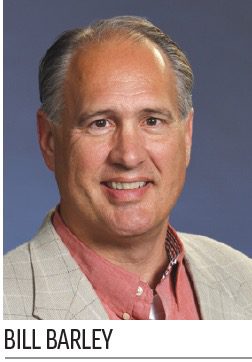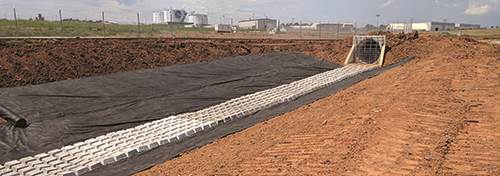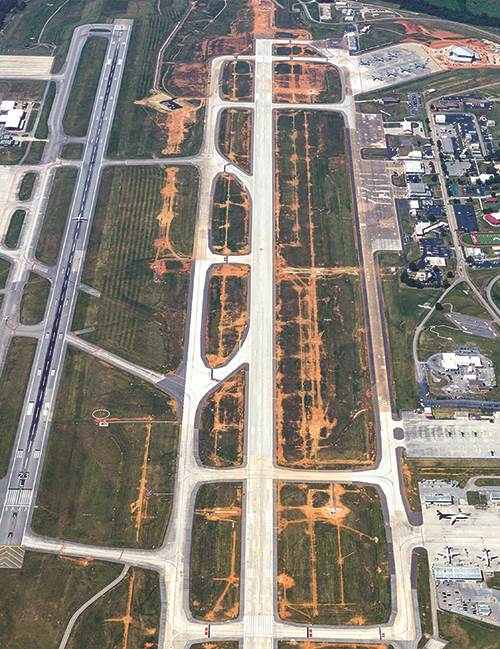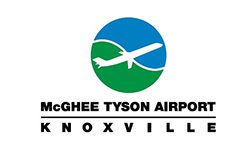The internet is full of videos about home improvement projects that mushroom in size and scope. What starts as a simple fix all too often becomes a complete redo. McGhee Tyson Airport (TYS) near Knoxville, TN, experienced a similar storyline when it undertook what was initially envisioned as a simple runway rehab in 2009. Spoiler alert: TYS installed fresh concrete, but also ended up extending and completely redesigning the runway…and installing a new instrument landing system (ILS) on the parallel runway.
The internet is full of videos about home improvement projects that mushroom in size and scope. What starts as a simple fix all too often becomes a complete redo. McGhee Tyson Airport (TYS) near Knoxville, TN, experienced a similar storyline when it undertook what was initially envisioned as a simple runway rehab in 2009.
Spoiler alert: TYS installed fresh concrete, but also ended up extending and completely redesigning the runway…and installing a new instrument landing system (ILS) on the parallel runway.
The $133.5 million effort, slated for completion this October, began with modest plans to repave and widen the shoulders of Runway 5L-23R. But an initial concrete survey found that 65% to 75% of the slabs needed to be replaced; and the remaining 25% of the pavement was 35 years old.
“We knew that within five to 10 years, we were going to be back out there replacing that 25% and breaking some of the new pavement,” says Eric Williamson, P.E., senior airport engineer and project manager for the Metropolitan Knoxville Airport Authority.
|
Project: Airfield Modernization Program Location: McGhee Tyson Airport, Knoxville, TN Owner/Operator: Metropolitan Knoxville Airport Authority (MKAA) Project Scope: Reconstruction & profile adjustments of Runway 5L-23R & impacted taxiway pavements; 500-ft extension of runway at each end; storm drain improvements; new runway & taxiway lighting; new airfield guidance signs & navigational aid facilities Enabling Project: Instrument landing system for Runway 5L-23L Total Cost: $133.5 million Funding: FAA; Tennessee DOT Aeronautics Division; TN Air National Guard; airport authority Construction: 2015–2021 Design Engineer/Program Manager: CHA Consulting Subconsultants: Michael Baker Int’l; Cannon & Cannon Inc.; S&ME; Holt Consulting; McGuiness Unlimited Construction Contractors: Eutaw Construction Co. (Projects 1, 2, 5, 6); The Harper Co. (Projects 3 & 4) Construction Subcontractors: DACO; Erosion Solutions; Kimberly; Skilled Services; Airfield Etc.; Precision Approach LLC; McCarthy; Whaley Construction Co.; MDI Contracting & Directional Drilling; APAC; Zebra Striping; American Stripers; Speidel Construction Inc.; Marking Impressions; Antigo Construction; Crush; Loudon County Fence; Archangel Protection Services; Pozzolanic Concrete Suppliers: The Harper Co.; Vulcan Materials; McCarthy; Harrison Construction Co. Asphalt Suppliers: APAC; Rogers Group; Pavement Restorations Inc. Lighting & Signage: ADB SAFEGATE Construction Barricades: OTW Safety |
That’s when the simple rehab turned into a full-blown reconstruction project. In 2010, the airport authority worked with CHA Consulting to start outlining a multi-year airfield modernization program. Initial planning led to two big questions: How are we going to pay for the improvements? How will we handle arrivals during adverse weather when our only ILS runway is closed for reconstruction?
Before airport officials could even think about ripping up and replacing Runway 5L-23R, they had to make sure the other runway, 5R-23L, was up to the job of handling all the airport’s traffic.
The Domino Effect
Bryan White, P.E., vice president of Engineering and Planning for the airport authority, notes that both runways were aging out at about the same time. This meant that the project team needed to address several enabling projects to ensure that inboard Runway 5R-23L stayed functional throughout construction. “If we didn’t take care of them, we were about to go from a two-runway airport to a zero-runway airport,” he jokes. “And we all know that those are not successful.”
To make the reconstruction project work, Williamson considered it essential to have an ILS on the airport’s most-used approach. But the FAA wasn’t willing to fund an ILS system on Runway 5R-23L using the reconstruction of Runway 5L-23R (which has CAT I and CAT II ILS equipment on the respective runway ends) as the justification for the new equipment.
During programming discussions, the airport authority held a forum to gather feedback about the impending airfield work from airlines, local tenants and other aircraft operators. Needless to say, none were thrilled when they heard that TYS could be without an ILS-equipped runway for three to five years during construction. In fact, some airlines indicated they would reduce service schedules without a Category 1 ILS runway.
“It was almost panic mode on our end,” recalls White. “But we felt that we could not move the dial with the FAA on this ILS expansion notion.”
So the project team looked for state resources instead.
Chasing the Money
The team succeeded securing a grant from the Tennessee Department of Transportation’s Division of Aeronautics to install an ILS on 5L-23L as an enabling project for the rehab of Runway 5L-23R.
But that only solved a small part of the budget issue. The airport regularly receives $4.2 million in annual entitlement funds plus state and local matching funds; and costs for the full project were estimated around $130 million. Officials consequently started looking for other sources, including the FAA Airport District Office in Memphis; and planners split the overall modernization plan into separate projects to help the funding process.
 “We really were taking this plan that we knew was going to be over $100 million and trying to phase it into projects that we didn’t know the dollar value of, because we were searching for FAA discretionary funds,” recalls Bill Barley, P.E., the program manager from CHA Consulting.
“We really were taking this plan that we knew was going to be over $100 million and trying to phase it into projects that we didn’t know the dollar value of, because we were searching for FAA discretionary funds,” recalls Bill Barley, P.E., the program manager from CHA Consulting.
When bidding individual projects, the team figured in cost escalation for the inflation, downtime and remobilization of contractors that would occur while TYS completed the full plan.
“We knew that once we finished the first phase of this project, the runway would be down and out of service, and we were not going to get it back until the whole project was over,” Barley explains. “So, there was a big push to try to accelerate that as much as possible because the finances were really the limiting factor that drove the schedule.”

Runway Reconstruction
After the ILS for Runway 5R-23L was flight-checked and commissioned in August 2015, the airport almost immediately took 5L-23R out of commission so contractors could start demolishing it.
The effort to rebuild it required much more than simply laying down new concrete. Williamson explains that bigger changes needed to be made because the runway was not meeting FAA standards that had evolved over time. For example, it had vertical curves in the last quarter and crossing taxiways within the middle third, a high-energy crossing area where the FAA generally wants to minimize or eliminate access. Plus, there was a significant line-of-sight issue that needed to be remedied.
 “We initially thought that this was going to be a remove-and-replace,” White says. “But with CHA’s programming and interaction with the FAA, we quickly realized we were going to bring the runway to current advisory circular standards.”
“We initially thought that this was going to be a remove-and-replace,” White says. “But with CHA’s programming and interaction with the FAA, we quickly realized we were going to bring the runway to current advisory circular standards.”
Now that the fixes have been made, the only thing left from the previous runway is its compass orientation (5-23). The vertical profile changed completely—each threshold was raised about 8 feet, and the center of the runway was lowered 8 feet. In turn, that meant replacing thousands of feet of taxiway leading to the runway to meet the 1.5% grade restriction.
The programming effort also identified the opportunity to add 500 feet on each end of the runway to aid missions of the Tennessee Air National Guard 134th Air Refueling Wing. The National Guard Bureau funded that portion of the project, and Runway 5L-23R is now 10,000 feet long.
Planners divided the overall rebuild into three phases.
During Phase 1, crews demolished and replaced about 3,000 feet of pavement to lower the middle of runway and raise the 23 end. This involved moving about 400,000 cubic yards of earth.
The remaining portions of the runway were removed during Phase 2, and contractors moved another 1 million cubic yards of earth. Officials note that every piece of concrete that workers pulled out was crushed and reused in the base course for the new runway and taxiways, saving millions of dollars in the process.
During Phase 3, contractors built out the rest of the concrete and reinstalled or replaced all electrical and ILS infrastructure, and then remarked the pavement.

The airport also improved its wildlife management plan by altering some of the stormwater management facilities and moving some temporary stormwater storage into the infield area.
Originally, the runway rebuild was expected to last three to five years but is taking longer than anticipated. “We are expecting to finish in October of this year,” Williamson reports. “We’ve had six-plus years of construction. It’s just the nature of the game that when you’re searching for funding each year, it’s going to extend the time you’re in construction.”
When the runway project is completely done, the airport will have a new electrical lighting vault with all new high-efficiency regulators, new LED signage, new LED runway and taxiway edge lighting and centerline lighting, and new controls for the tower and maintenance providers.

Airport officials note that the environmental efficiency of the runway has improved 100%, and thoughtfully designed taxiways will prove incredibly efficient for airlines—thus increasing the usage of exit taxiways and decreasing taxi time, which saves fuel and decreases emissions.
Collaboration & Relationships
Working together is a prominent thread that runs throughout the narrative of TYS’ airfield modernization.
“I’d really define this whole project as partnerships and relationships,” says White. “That means relationships and partnerships with the local station managers, Memphis ADO, the local military and the local FBO. It’s partnerships and relationships with CHA. Without their guiding hand throughout this program, we would not be where we are today.”
He highlights CHA’s relationship with the FAA as a game-changer, adding that the airport authority and its design engineer/program manager made multiple trips to FAA headquarters to smooth friction points and discuss where they needed help to keep the project moving forward.
 Adding complexity, the airport authority’s previous president retired three-quarters of the way through the project. That’s when Patrick W. Wilson, AAE, assumed the leadership role. White credits Wilson for quickly forming partnerships and relationships with all the key players, trusting what the team had done to date and jumping in to help sort out the future.
Adding complexity, the airport authority’s previous president retired three-quarters of the way through the project. That’s when Patrick W. Wilson, AAE, assumed the leadership role. White credits Wilson for quickly forming partnerships and relationships with all the key players, trusting what the team had done to date and jumping in to help sort out the future.
Looking back, White says that the team has had so much success communicating and collaborating through the years, it changed how the airport authority will approach future projects.
Part of the successful strategy was to create a forum for airport users—from general aviation operators to airline property managers—and for the airport authority to listen to their needs and concerns. Thanks to those efforts, White believes stakeholder relationships are stronger now than before the project began.
He also credits the authority board for entrusting and empowering him and his staff. “When you’re a board that’s dealing with a $100-plus million project, it needs to be acknowledged that the trust to execute this started with them. If we weren’t on the same page with our board, we just wouldn’t be sitting here with this successful of a runway project.”
Personnel from CHA Consulting are quick to credit lead contractors Eutaw Construction and The Harper Company as well.
“They were big, big partners in helping get this done successfully,” Barley remarks. ”We need to recognize the contributions that the construction community made to this project—including one equipment operator who has been on site since Day One.”
From the first project all the way through the sixth, there has been an attitude of “Yes, we can get this done,” says Barley.
“To me, that’s a reflection of the authority’s leadership and the fact that it is a very, very strong business partner to the people that they work with—us as a consultant, contractors and every one of their tenants,” he explains. “They understand that it’s part of their responsibility to help everybody succeed. And when the owner of the project brings that attitude, it’s easy for that to trickle down through all participants.”

White says that there was concern among the traveling public about how construction would affect service, but it ultimately proved to be unfounded. The airport authority kept travelers and the local community apprised of progress through the TYS website, local public relations efforts, social media and a podcast called From the Runway Up.
“There’s not any sort of story where customer service has been altered, impacted or deviated,” White reports. “For us, that’s a pretty important thing, because our board always wants to know if we are impacting or frustrating travelers.”
With the project all but complete, officials are confident that the investment, and even slight delay, will be worth it. Wilson notes that the runway extension and other airfield improvements poise TYS for a bright future, including opening longer stage lengths for air carriers. “McGhee Tyson Airport plays a vital role in supporting the business, tourism and leisure transportation needs of the region’s economy,” he says. “The reconstruction of Runway 5L-23R has prepared our airfield to serve our community’s aviation needs for the next 50 years.”
|
Becoming a One-Runway Wonder McGhee Tyson Airport (TYS) near Knoxville, TN, had grown accustomed to operating as a two-runway airport. If officials needed to close one runway for maintenance, mowing or painting, it was never a problem to temporarily move traffic to the other. But it was a frightening proposition when a pavement reconstruction project required closing one runway for years instead of hours. “I think, internally, we questioned how we would survive,” recalls White. “Our Operations Department had to go out and talk with other one-runway airports so they could calm us down and reassure us that we were going to make it.” Boosted with newfound confidence, TYS management felt up to the challenge. Of course, in their minds the challenge would be maintaining the current level of operations with just one runway. But the market dealt them a major surprise. As construction progressed from 2016 through 2019, TYS started breaking every one of its enplanement and total passenger records. The airport experienced 43 months of consecutive growth and hit an all-time high of 2.5 million total passengers in 2019. Then, traffic slowed dramatically in March 2020 due to COVID-19. The exciting growth was not without challenges. For example, at the start of the project, maintenance crews could work from 10:30 p.m. to 6 a.m. without disrupting any airfield traffic. With the increased capacity, however, their window narrowed to just a few hours per night. “We went from a mindset of ‘How does any airport survive without two runways?’ to putting more traffic on one runway than we ever had on two runways combined,” White recalls. Handling the growth without a hitch was the result of planning and cooperation. Everybody at the airport authority, airlines and tenants operations all worked it out together, he explains. |


 facts&figures
facts&figures

